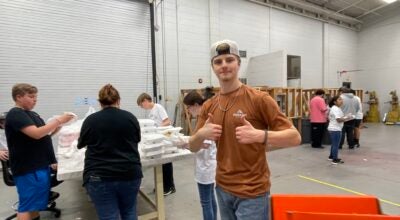Wellness Wednesday: Training Concept Series Pt. 3. – Core
Published 9:37 am Wednesday, May 3, 2023
Though cardio and strength training – discussed in previous weeks – often precede many other types of exercise when setting fitness goals, every plan must begin at the literal “core” of it all: your core! Core training benefits one’s overall posture, stability, balance, injury prevention, performance enhancement, and ability to rehabilitate from an injured state. The body’s core musculature consists of global and local musculature, all of which work together to improve the attributes listed above.
Although many associate core training with sit-ups, crunches, planks, and other ab-burning exercises, the body’s core consists of the musculature of the entire pelvis and trunk area, responsible for stabilizing the trunk and spine. Global muscles include those most often thought of when performing core-focused workouts, such as: the rectus abdominis (the large abdominal muscle along the front, center region of the body) and the external and internal obliques (“side abs”), as well as muscles of the back and hips: erector spinae (a long muscle located along the spine), latissimus dorsi ( the large, superficial muscle spanning the back), and the iliopsoas (a muscle on the front of the body that allows for hip flexion). Local muscles, smaller muscles found beneath the global muscles, consist of: the rotatores (stabilizers of each spinal segment), multifidus (located beneath the erector spinae, and responsible for stabilization, extension, and rotation of the spine), transverse abdominis (a deep abdominal muscle), the diaphragm, pelvic floor musculature, and the quadratus lumborum (providing side-bending movement of the spine and elevation of the pelvis).
While anatomy may not interest many individuals outside the profession of health and wellness, knowledge of this specific make up of the body contributes to one’s understanding of the importance of a strong core altogether. In order to maintain optimal production, transfer, and control of the constant forces acting on the body, the core region must actively control the position of the trunk over the pelvis as it moves through space. Without a strong, stable core, the body will likely experience excess stress outside its preferred range and plane of motion, leading to repetitive injury. Lack of core strength can also lead to common symptoms of low back pain. Exercises that target all core muscle groups, including the low-back, obliques, gluteal complex, and abdominal musculature are therefore essential to one’s exercise plan and contribute to a person’s overall ability to move well and optimally. As mentioned in the introduction, and beyond that, core training leads to enhanced spinal health and posture, increased balance, stability, and coordination, improved technical and mechanical skill as it relates to movement and power, and improved overall bodily function for performing functional tasks.
A general rule of thumb when engaging in core training is to start with stabilization-focused exercises, meaning the exercise consists of little to no movement of the spine. Such exercises include bird-dogs, fire hydrants, dead bug, bridges, planks, and pallof presses, and they primarily target the local core musculature in order to improve neuromuscular efficiency and intervertebral stability. Once improved, you can progress to more dynamic core movements such as: crunches, back extensions, cable rotations, and reverse crunches, and then eventually to power-centered movements, including med-ball throws and passes. These exercises improve lumbopelvic stability, eccentric and concentric strength of the core musculature, coordination, and maximal force generation (Sutton, 528).
Core training literally remains at the core of it all. The core allows the body to achieve optimal posture and perform all kinds of movements as they relate to both fitness and every-day life. Strong core, strong body!





